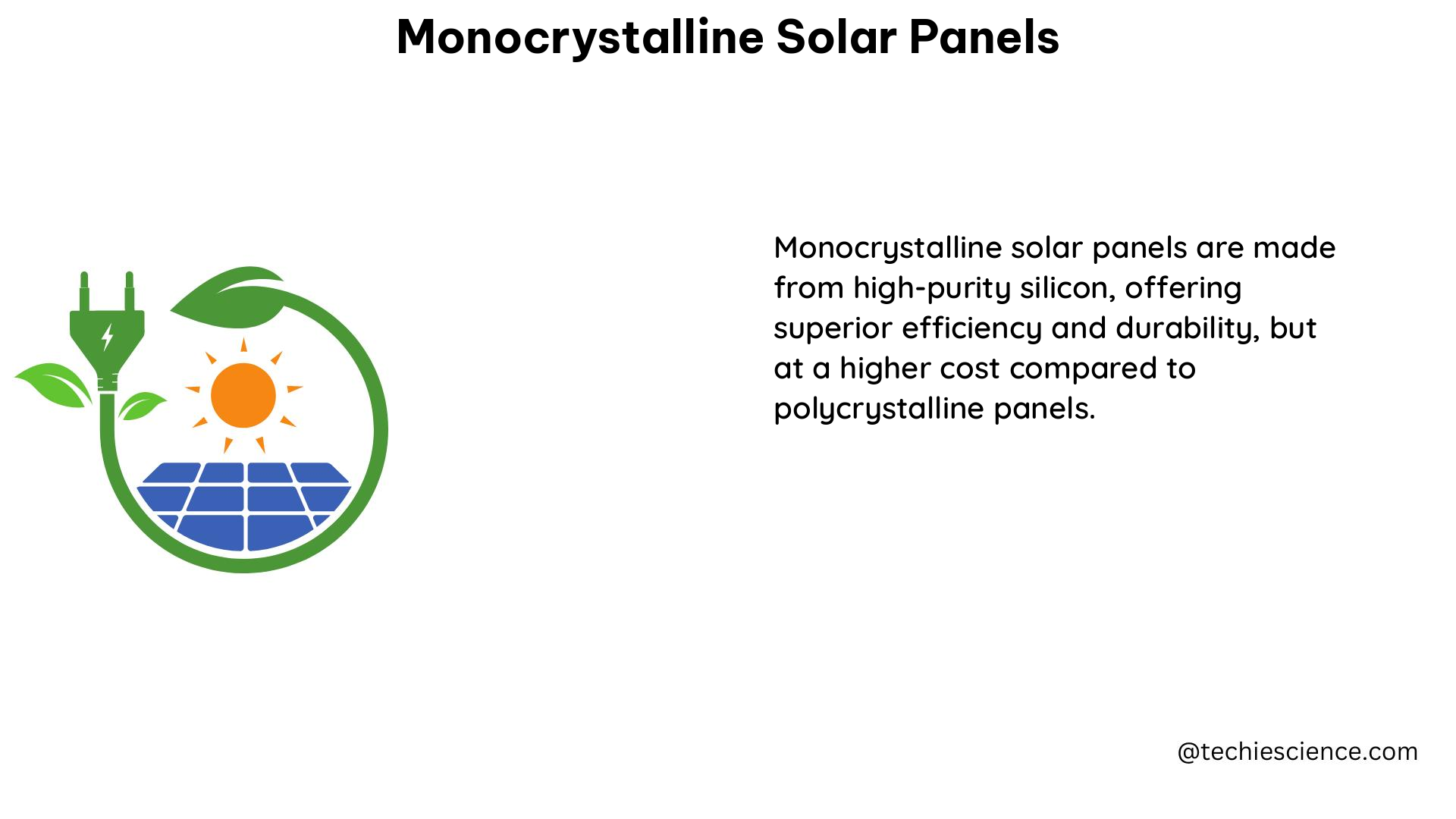Monocrystalline solar panels are known for their exceptional efficiency, typically ranging from 15% to 20%. This high efficiency is attributed to the use of single pure silicon crystals, resulting in a uniform dark color and rounded edges. The superior performance of monocrystalline solar panels makes them a popular choice for space-constrained installations where maximizing energy production is crucial.
Understanding Monocrystalline Solar Panel Efficiency
The efficiency of a monocrystalline solar panel can be calculated using the formula: Efficiency = (Panel Power / (Panel Length x Panel Width)) x 100%. For instance, a 300W monocrystalline solar panel with dimensions of 1.64m x 0.99m would have an efficiency of approximately 19.5%.
To evaluate the efficiency of a monocrystalline solar panel under standard test conditions (STC), the formula ηmp,STC = (YPV / (APV x GT, STC)) can be used. STC includes a cell temperature of 25°C, solar irradiance of 1000 W/m², and air mass of 1.5.
When compared to polycrystalline solar panels, monocrystalline panels have a clear advantage in terms of efficiency, with a range of 15% to 20% compared to polycrystalline panels’ efficiency range of 13% to 16%. This difference is due to the use of single pure silicon crystals in monocrystalline panels, which allows for better electron movement and higher electricity generation.
Measuring the Power of Monocrystalline Solar Panels

For a DIY approach to monocrystalline solar panels, you can use a multimeter to measure the voltage and amperes generated by the panel. This will help you determine the maximum power point, which is the point at which the panel produces the maximum amount of power. By adjusting the load resistance to match the panel’s dynamic resistance at the maximum power point, you can optimize the panel’s efficiency and ensure maximum power transfer.
It’s important to note that the maximum power point may not always occur at the panel’s rated voltage and current. Instead, it may occur at a different voltage and current level, which can be determined through measurements and calculations. By finding the maximum power point, you can ensure that your monocrystalline solar panel is operating at its highest possible efficiency and generating the maximum amount of power for your needs.
Advanced DIY Approach: Using a Rheostat
For a more advanced DIY approach, consider using a rheostat to achieve a fully variable resistance between a minimum value of zero Ohms (0Ω) and a maximum value of 6Ω. This can help you fine-tune the load resistance to match the panel’s dynamic resistance at the maximum power point, further optimizing the panel’s efficiency and ensuring maximum power transfer.
By using a rheostat, you can precisely adjust the load resistance to find the optimal point where the panel’s power output is maximized. This can be particularly useful when dealing with fluctuating environmental conditions, such as changes in solar irradiance or temperature, which can affect the panel’s maximum power point.
Monocrystalline Solar Panel Maintenance and Troubleshooting
To ensure the long-term performance and efficiency of your monocrystalline solar panels, it’s essential to perform regular maintenance and address any issues that may arise. This includes:
- Cleaning the Panels: Regularly cleaning the panels to remove dirt, dust, and debris can improve their light absorption and overall efficiency.
- Monitoring Performance: Regularly monitoring the panel’s voltage, current, and power output can help identify any performance degradation or issues.
- Shading Mitigation: Ensuring that the panels are not shaded by nearby objects, such as trees or buildings, can prevent a significant drop in power output.
- Thermal Management: Maintaining proper airflow and cooling around the panels can help prevent overheating, which can reduce their efficiency.
- Wiring and Connections: Regularly inspecting and maintaining the wiring and connections to ensure they are in good condition and not causing any power losses.
By following these maintenance and troubleshooting steps, you can maximize the long-term performance and efficiency of your monocrystalline solar panels.
Conclusion
Monocrystalline solar panels offer exceptional efficiency and are a popular choice for space-constrained installations. By understanding the technical specifications of these panels and using appropriate measurement techniques, you can ensure that your monocrystalline solar panel is operating at its highest possible efficiency and generating the maximum amount of power for your needs.
Whether you’re a DIY enthusiast or a solar energy professional, this comprehensive guide on monocrystalline solar panels provides the necessary information and tools to optimize your solar energy system and maximize your energy production.
References:
- How is Solar Panel Efficiency Measured?
- Measuring the Power of a Solar Panel
- Monocrystalline vs. Polycrystalline Solar Panels
- Monocrystalline vs. Polycrystalline Solar Panels: Which is Better?
- Solar Panel Efficiency: A Comprehensive Guide
- How to Choose the Best Solar Panels for Your Home
- DIY Solar Panel Installation: A Step-by-Step Guide

The lambdageeks.com Core SME Team is a group of experienced subject matter experts from diverse scientific and technical fields including Physics, Chemistry, Technology,Electronics & Electrical Engineering, Automotive, Mechanical Engineering. Our team collaborates to create high-quality, well-researched articles on a wide range of science and technology topics for the lambdageeks.com website.
All Our Senior SME are having more than 7 Years of experience in the respective fields . They are either Working Industry Professionals or assocaited With different Universities. Refer Our Authors Page to get to know About our Core SMEs.